![]()
![]()
![]()
Use LEFT and RIGHT arrow keys to navigate between flashcards;
Use UP and DOWN arrow keys to flip the card;
H to show hint;
A reads text to speech;
56 Cards in this Set
- Front
- Back
|
Coherent |
When 2 wave sources emit waves with a constant phase difference |
|
|
Path difference |
Difference in distance travelled of 2 coherent waves at a fixed point |
|
|
Phase difference |
Fraction of a cycle between the vibrations of 2 particles |
|
|
Progressive wave |
Transfers energy e.g. Longitudinal & transverse |
|
|
Progressive wave |
Transfers energy e.g. Longitudinal & transverse |
|
|
Polarisation |
When waves are limited to travel in only one plane |
|
|
Progressive wave |
Transfers energy e.g. Longitudinal & transverse |
|
|
Polarisation |
When waves are limited to travel in only one plane |
|
|
Rarefraction |
Wide gaps in longitudinal waves |
|
|
Progressive wave |
Transfers energy e.g. Longitudinal & transverse |
|
|
Polarisation |
When waves are limited to travel in only one plane |
|
|
Rarefraction |
Wide gaps in longitudinal waves |
|
|
Compression |
Small gaps in longitudinal waves |
|
|
Superposition |
When two waves combine whilst passing through eachother |
|
|
Superposition |
When two waves combine whilst passing through eachother |
|
|
Constructive interference |
When 2 waves interfere and construct a wave double the size |
|
|
Destructive intereference |
When 2 waves cancel eachother out |
|
|
Destructive intereference |
When 2 waves cancel eachother out |
|
|
Stationary waves |
Formed when 2 progressive waves combine to create a wave via superposition. Do not transfer energy |
|
|
Destructive intereference |
When 2 waves cancel eachother out |
|
|
Stationary waves |
Formed when 2 progressive waves combine to create a wave via superposition. Do not transfer energy |
|
|
Nodes |
Points of 0 amplitude |
|
|
Destructive intereference |
When 2 waves cancel eachother out |
|
|
Stationary waves |
Formed when 2 progressive waves combine to create a wave via superposition. Do not transfer energy |
|
|
Nodes |
Points of 0 amplitude |
|
|
Antinodes |
Points of max amplitude |
|
|
Diffraction |
When light spreads out after passing through a gap |
|
|
Diffraction |
When light spreads out after passing through a gap |
|
|
Monochromatic light |
All light has same wavelength and frequency (& colour) |
|
|
Diffraction |
When light spreads out after passing through a gap |
|
|
Monochromatic light |
All light has same wavelength and frequency (& colour) |
|
|
Optimum diffraction when... |
Gap size = or similar to wavelength |
|
|
Diffraction from single slit |
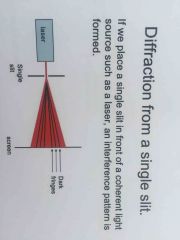
Coherent light source (laser) causes red light with dark fringes |
|
|
Two source interference (SOUND WAVES) |

Constructive (maxima), destructive (minima) |
|
|
Two source interference (SOUND WAVES) |
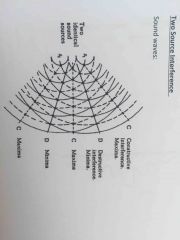
Constructive (maxima), destructive (minima) |
|
|
Two source interference (MICROWAVES) |
Alternating pattern of strong and weak signals |
|
|
Two source interference (SOUND WAVES) |
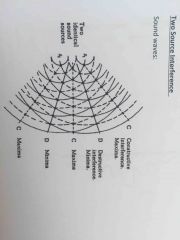
Constructive (maxima), destructive (minima) |
|
|
Two source interference (MICROWAVES) |
Alternating pattern of strong and weak signals |
|
|
Young's double slit |
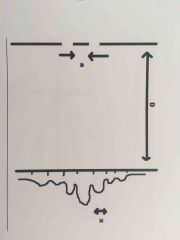
Fringe separation = lambda*slit separation/distance between slit and screen |
|
|
Diffraction gratings |

Back (Definition) |
|
|
Diffraction gratings |
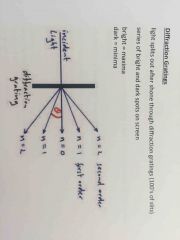
Back (Definition) |
|
|
Applications of diffraction gratings |
Spectrometer (study spectrum accurately) |
|
|
Diffraction gratings |

Back (Definition) |
|
|
Applications of diffraction gratings |
Spectrometer (study spectrum accurately) |
|
|
Refraction |
When light bends after entering a new medium |
|
|
Less-> more dense.... |
Towards normal |
|
|
More-> less dense... |
Away from normal |
|
|
Snell's law |
n1sin01=n2sin02 |
|
|
Snell's law |
n1sin01=n2sin02 |
|
|
Total internal reflection |
Occurs when angle of refraction is 90, and light is no longer refracted but internally reflected |
|
|
Optical fibres |
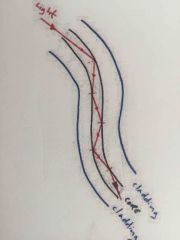
Cladding has lower refractive index, creates step index, prevents light being lost from core |
|
|
Optical fibres |
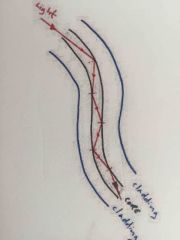
Cladding has lower refractive index, creates step index, prevents light being lost from core |
|
|
Modal dispersion |
Occurs in wide core, light travels shorter distance than light undergoing total internal reflection, pulse of light too long, could merge with next core |
|
|
Material dispersion |
Occurs if white light used, speed of light depends on wavelength of light, difference in speed cause light pulses too long, could merge with next core |
|
|
Optical fibres role in communications |
Allows pulses of light to go from transmitter to receiver. Should be highly transparent to minimise absorption of light |
|
|
Optical fibres role in medical endoscope |
Endoscope inserted to body cavity, illuminated with light by optical fibre 1. Lens on 2nd optical fibre used to form image. Light to form image travels along fibres to other end of bundle, for image to be observed.
|

